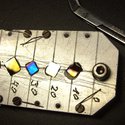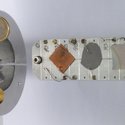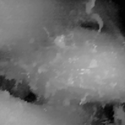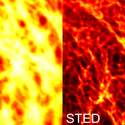Newsportal - Ruhr-Universität Bochum
Methoden

Instabile Isotope werden auch heute noch in einem breiten Spektrum von Forschungsfeldern eingesetzt, von den Lebenswissenschaften bis zur Materialforschung. Der Umgang erfordert jedoch besondere bauliche und administrative Maßnahmen. Wir bieten Laborräume, in denen mit radioaktiver Starhlung umgegangen werden kann sowie Unterstützung in den zugehörigen, administrativen Abläufen.

Die leichten Elemente Lithium, Kohlenstoff, Stickstoff und Sauerstoff lassen sich mit D-NRA nachweisen.

Die Kernreaktionsanalyse (NRA) und die elastische Rückstreuspektroskopie (EBS) sind zwei der am häufigsten verwendeten Techniken für die quantitative Tiefenprofilierung leichter Elemente. Sie sind beide wenig zerstörerisch und zeichnen sich durch hohe Genauigkeit und Empfindlichkeit aus. NRA bietet darüber hinaus eine hohe Isotopenselektivität, eine erhöhte Empfindlichkeit für viele Elemente und die Möglichkeit der gleichzeitigen Analyse mehrerer leichter Elemente in oberflächennahen Schichten. Diese Techniken sind jedoch auf experimentelle Wirkungsquerschnitte für die untersuchten Kernreaktionen oder elastische Streuung angewiesen.

Gammaspektroskopie zur Materialanalyse und Untersuchungen von in der Nuklearen Astrophysik relevanten Kernreaktionen.

Hochenergie-Ionenimplantation
RUBION und die rubitec GmbH führen im Kundenauftrag Ionenbestrahlungen im MeV Bereich durch. Dabei steht ein großes Spektrum an unterschiedlichen Ionen zur Verfügung. Der verfügbare Energie- und Dosisbereich ist dabei von der jeweiligen Spezies und der Wafer-Größe abhängig. Die Möglichkeiten werden von uns anwendungsabhängig auf Anfrage ermittelt.
Wir sind nach DIN EN ISO 9001: 2015 zertifiziert.

Die Ionenimplantation ist eine vielseitige Methode der Materialmodifikation mit ganz unterschiedlichen Anwendungsbereichen.

Tiefenprofilierung von Wasserstoff mit der 15N Methode:
Diese Methode erlaubt eine tiefenaufgelöste Bestimmung der absoluten H-Konzentration.

PIXE ist eine nuklearanalytische Technik, ideal für die Detektion und Quantifizierung von Spurenelementen. Es ist die am häufigsten verwendete Methode für die Massenanalyse von geologischen, biologischen, Umwelt- und Kulturerbeproben.

Langzeitaufnahmen lebender Zellen ermöglichen es, zellphysiologische Prozesse, die in einem zeitraum von Minuten bis Stunden stattfinden, zu untersuchen. Typische Beispiele sind Zellmigration, Zelldifferenzierung und Zellwachstum. In Kombination mit mehrkanaligen Fluoreszenzaufnahmen kann ebenfalls die Änderung der verteilung eines oder mehrerer Proteine innerhalb der Zelle beobachtet werden.

Rutherford-Rückstreu-Spektrometrie ermöglicht es, die chemische Zusammensetzung von Materialien zu bestimmen. In unterschiedlichsten Bereichen wird RBS zur Charakterisierung von Proben angewandt.

Die Raster-Ionenleitfähigkeitsmikroskopie (engl.: Scanning Ion Conductance Microscopy, SICM) ist ein kontakfreies Raster-Sondenmikorksopie-Verfahren. Es erlaubt die Abbildung der Oberfläche einer Probe in Elektrolytlösung und bei Raumtemperatur. In der SICM wird eine Glas-Mikro- oder -Nanokapillare als Sonde eingesetzt. Der Strom durch die Öffnung der Kapillare wird genutzt, um den Abstand zwischen Probenoberfläche und Sondenöffnung zu bestimmen.

Die "Stimulated emission depletion" (STED) Mikroskopie umgeht die Beugungsgrenze des Lichts durch das Ausnutzen der physiko-chemischen Eigenschaften des Fluorophors. Sie erlaubt die Aufnahme fluoreszierender Proben mit einem höheren Detail-Level im Vergleich zu beugungsbegrenzten Methoden wie der konfokalen Mikroskopie.

Räume für die Ausbildung von Studierenden, Labore (Aufdampflabor, Halbleiterlabor) ohne Kontrollbereich nach Strahlenschutzverordnung (StrlSchV).

XPS und AES sind empfindliche Analysemethoden, die am RUBION als Erweiterung und in Ergänzung zu den Ionenstrahlmethoden eingesetzt werden.

